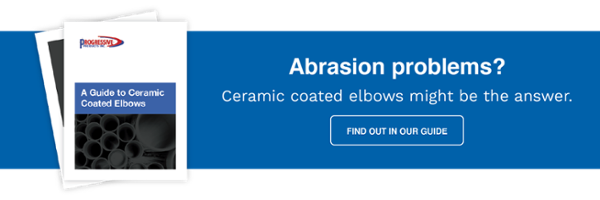We all appreciate how pneumatic grain conveying systems help us move grain through the air by shooting it through a system of blowers, airlocks, separators, and pipelines. While efficient, this system is susceptible to damage from friction and impact abrasion due to the high speeds the grain travels at.
Thankfully, there are several ways that you can help minimize the damage your pneumatic grain conveying system takes during operation.
Use Fewer Bends to Reduce Impact Abrasion
Impact abrasion occurs when the grain, traveling at high speed, is forced to change direction suddenly and creates microscopic tears along the inside of the bend as it rubs against it. Over time, these abrasions build up, eventually causing enough damage to wear holes through the bend, resulting in pressure loss, downtime, and costly repairs.
One way you can reduce the effect of impact abrasion is by decreasing the number of pipe bends in the system. Fewer bends result in fewer places where impact abrasion can occur. Fewer bends also mean longer pipelines, which helps protect the other bends in the system. This is because shorter pipe lengths worsen the severity of impact abrasions by giving the grain less time to change direction, resulting in greater velocity and more damage. But with longer, straighter pipe sections, the grain is given more time to slow down when changing direction, resulting in less wear and tear.
Use Abrasion Resistant Elbows
Because impact abrasion at the bends of your system is unavoidable, another way to minimize damage is by using products designed to extend the life of your pipe elbows. While there are many different types of elbow designs, most function by having an additional back covering along the sides and back of the bend to safeguard against holes and blowouts.
- The Ceram-Back® elbow incorporates a ½” ceramic compound jacket fitted across the back of a bare or core elbow. This ceramic compound is incredibly hard and serves as a backup for when the regular elbow is worn through. These elbows can facilitate both ‘clean side’ grain (grain that’s already gone through the manufacturing process) and ‘dirty side’ grain material (straight from the earth).
- A mortar-filled flat-back elbow (or cement-back) has a back cavity filled with hard concrete that extends the life of the elbow by transferring the abrasion to the concrete once the material has worn through the core elbow. However, this option is only suitable for ‘dirty side’ grain or waste products such as grain hulls, as there’s the risk of friability and contamination from the mortar, making it unsuitable for clean grain.
Keep Up On Maintenance
While pneumatic grain conveying systems are relatively low-maintenance, it’s important to remember to follow the rules for your conveying systems' regular preventive maintenance. A well-maintained system will help you avoid costly mechanical failures and damages down the road.
Standard preventive measures include cleaning out any dust or dirt buildup within each section, keeping moving parts properly lubricated, adjusting belts and replacing them as needed, checking and cleaning exhaust ports, and inspecting bearings regularly for signs of wear.
A grain conveying system is a sizable investment for any business. Whether it’s the only machine you use or one of many, you want to save time and money by keeping it in good working condition. By minimizing wear through straighter lines, reinforced elbows, and regular maintenance, you’ll cut down on operational costs in the long run by reducing downtime, accidents, and costly replacements.
Contact Progressive Products Inc. today and let us discuss your pneumatic conveying needs. We want to match you with the perfect solution and will never sell you anything you don’t need.


